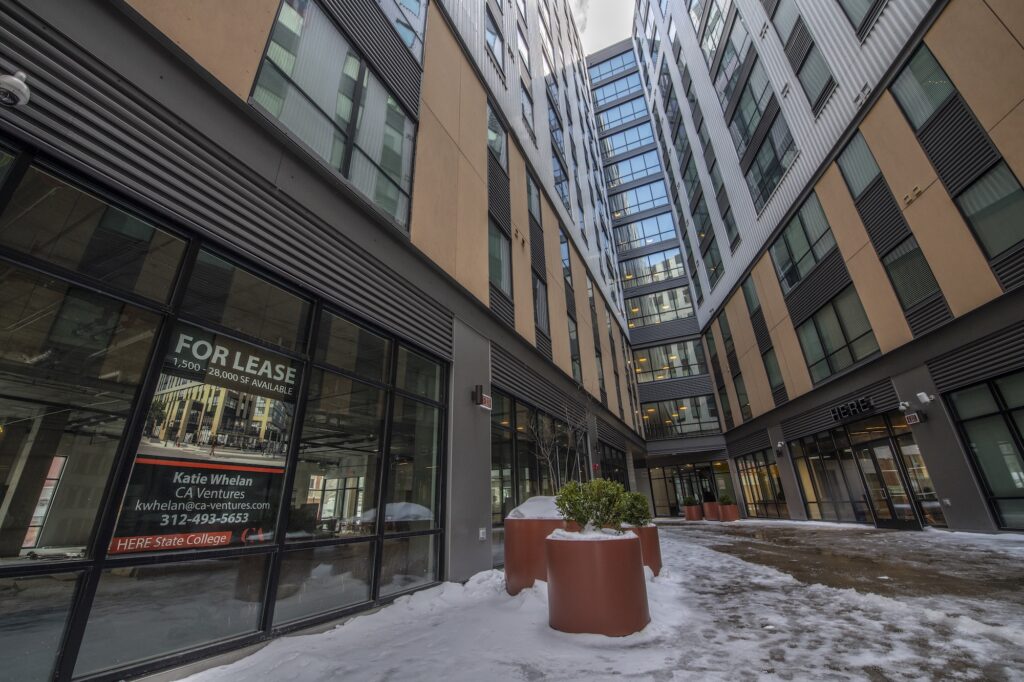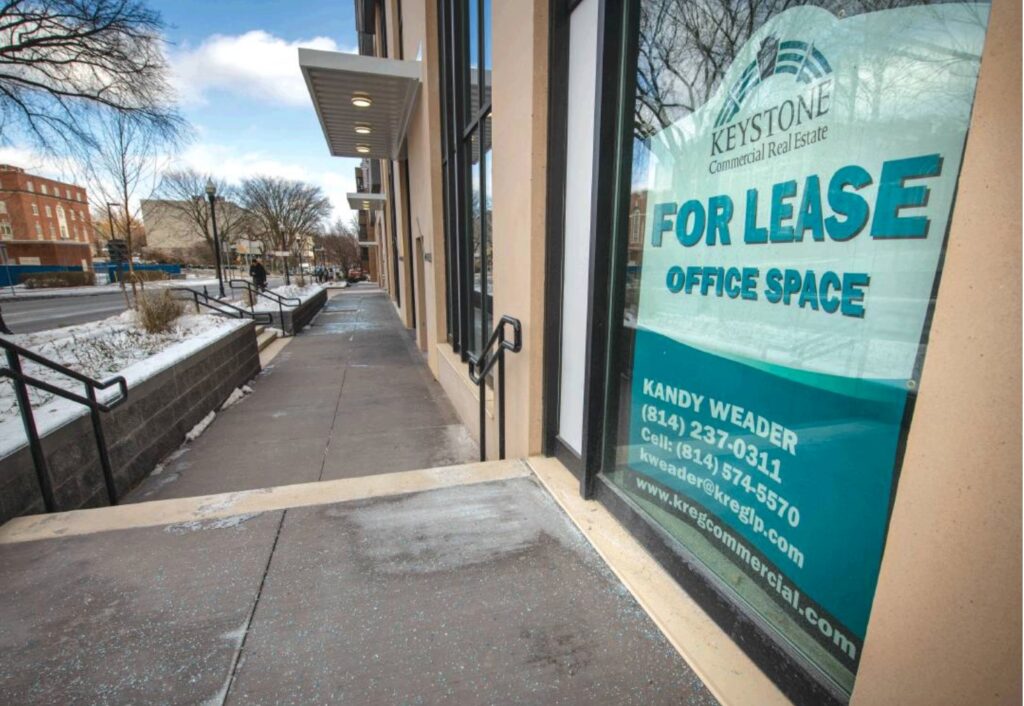
Kandy Weader of Keystone Real Estate at The Standard, 330 West College Avenue (Photo by Darren Andrew Weimert)

Kandy Weader of Keystone Real Estate at The Standard, 330 West College Avenue (Photo by Darren Andrew Weimert)
From 2016—when the Fraser Centre kicked off the high-rise boom—to 2023—when the currently under construction 12-story building on Hetzel Street and College Avenue is planned to open—roughly 320,000 square feet of retail and commercial space will have been added to State College in newly constructed high-rise apartment buildings downtown. That is about the size of two Walmart Supercenters.
When developers introduce these new projects, all that space always sounds pretty great. Who wouldn’t want a new grocery store in the heart of town besides interesting boutique stores? What’s not to like about fun restaurants with outdoor seating in the busy parts of town, and commercial space to draw firms with high-paying jobs for young professionals?
Yet, despite all this promise, much of this space remains empty. The borough and others are working to help the space live up to its potential of providing a more vibrant and modern downtown.
A plan with bookends
State College’s recent upward growth started in the early 2000s, long before borough Director of Planning Ed LeClear came onboard in 2014.
A downtown development strategy was put in place in coordination with the Downtown Improvement District, with the realization that growth was needed somewhere to help increase the tax base while preserving some of the small-town feel that people have grown to love about State College.
The plan was “focused on mixed-use development and encouraging more commercial space downtown,” says LeClear. Zoning changes in 2005 and a few amendments in 2006 and 2007 helped usher in larger high-density projects. The tradeoff for being able to build higher was that the plans had to include at least two floors of commercial space.
“The logic of council at the time, and has been since, was to increase the density on the edges of downtown, almost like bookends, and to preserve what I would consider the main street—the heart of downtown being really from the churches on College [Avenue] down Burrowes [Street] and the Allen [Street] spine of the 100 to 200 block,” says LeClear.
Another big zoning change came in 2013, which LeClear says “allowed The Metropolitan to get the changes made at that time that really opened up the door for more of the student housing developments or purpose-built student housing.”

He says the zoning focus was for a mix of use, not just residential apartments. “The second main objective was to get more businesses to locate. That’s why you see the second-floor office space. So, it wasn’t just for the retail spaces on the first floor; it was also to get firms to locate in downtown.”
If you zone it, they will come
With that zoning in place, downtown has developed that bookend feeling they were looking for, with new high-rises now dominating the east and west sides of town.
On the west side, standing tall above the rest of the skyline, are 12-story Fraser Centre (opened in 2016), The Metropolitan (2017), and the recently opened The Standard.
On the east side of town, the 12-story Rise sprouted up in 2018, followed by the 12-story The Maxxen (formerly Here State College). Between Rise and Maxxen, construction for another 12-story mixed-use building on the corner of Hetzel began last year. Chicago-based Core Spaces plans to wrap up construction in 2023.
All these spaces contain that mix of retail and commercial space on the bottom floors.
On Beaver Avenue, seven-story The Edge opened in 2018 with office space on the top floor and retail space on the ground floor. The seven-story Pugh Centre opened in 2020 with 6,000 square feet of yet-to-be-filled commercial space on the first two floors and apartments on the remaining five floors.
That is a lot of growth in a short time. Some of the potential of these spaces has been unlocked. Preceding the student housing rush, Fraser Centre opened with tenants in place including a hotel, Target, condominium occupants, and H&M (H&M recently vacated their space in the building).

In 2020, right before the pandemic began, local start-up KCF Technologies opened its new main office in the commercial space on the second floor of The Metropolitan, giving the high-rise on the main intersection of town another major tenant to go along with local favorite Tadashi Japanese Restaurant’s second location and national gym brand Orange Theory Fitness in the bottom retail space. But other buildings’ retail and commercial spaces remain vacant, with only a few businesses trickling in. Was it too much, too fast?
The student housing boom that hit downtown was part of a national trend over the last decade, says LeClear, “and I think that that has led to larger development that’s more student focused than I think would have been imagined in 2005, 2006, and 2007, when the initial ordinances were put in place. I think that’s a fair statement. I do think that we need to really focus on what is it going to take to get the space that’s been built, with businesses in it and with firms located. I think if we can get those full, it will really add to the character of downtown and add to the economic strength of downtown, but we have a ways to go.”
Opportunity with challenges
Kandy Weader from Keystone Real Estate, who manages some of the commercial real estate for The Standard and Rise, says the downtown locations provide an excellent opportunity for businesses.
She says these newer buildings are attractive assets to help bring new retail businesses to the area, even if they are slow to fill.
“We have always had a low retail vacancy rate and we just didn’t have spaces for the brands looking to come to market previously. Now there are options for them, although most want to be on College Avenue and are still choosey about where they want to land,” says Weader. She says even before the pandemic, the “Amazon effect” of online shopping was hurting retail store brands, making them less likely to open storefronts, while food and beverage, including fast-casual restaurants, was still booming.
“Then the pandemic hurt the fast casuals. As the pandemic subsides, I expect that we will see another boom of fast casuals and strong retailers needing bricks and mortar,” says Weader.
Of the commercial space available, Lee Anne Jeffries, Executive Directive of DID, says, “having options for office space downtown is a plus; we want to attract and retain companies so their employees work, eat, shop, and raise their families here.”
KCF’s new office is a great example, but leasing the new office space “is a little more tricky” than leasing retail space, says Weader. “We don’t have a lot of Class A office users in the entire State College area. The new spaces downtown are Class A and pricey, so we have a small target market for them. Many of the Class A office users also have high parking ratios and/or can’t afford the needed paid parking, so they settled in the outlying areas.”

Parking is one of three challenges related to the current open spaces that LeClear can see. Zoning, he says, is “requiring too much residential space and not enough commercial space for the parking” in these new structures.
State College’s public parking structures are located in the heart of downtown, not on the edges where these new buildings are required to be.
“We don’t have garages down where Rise is or up where The Metropolitan is. We don’t have a public garage that close. So, I think that’s been another challenge, is just how do we get the right amount of public spaces nearby,” says LeClear.
“The downtown parking ratio is much lower than the national averages for retail and office establishments. We have been brainstorming with the planning office on how we can help alleviate the parking issues to attract more tenants,” says Weader.
LeClear says to look for a potential upcoming zoning change to reduce some of the required residential parking and increase the use of those spaces for commercial tenants. Other potential fixes that might help include finding ways to make the already existing parking structures in the borough more workable for potential users of the new commercial spaces.
Another issue is that the people who are building these developments are not local, says LeClear. They usually sell the building as soon as it has been constructed.
“So, the entities that are building the buildings are not necessarily the ones who are involved in trying to lease the space. So, the challenges are that we’ve moved from a local environment of local developers and local owners to one that’s national,” says LeClear. “And, as you can tell, there hasn’t been a lot of actual movement in getting those properties leased up.”
He says that where they have seen success is in The Metropolitan, which was handled by local brokers at Keystone, who are more invested in the community and are putting the resources into the properties.
The third challenge LeClear mentioned was that the commercial spaces require a lot of work for businesses to “fit out.”
The developers are required to include the commercial spaces, but they build them to minimum because they don’t have as much value to them as the apartments above, he says.
“When regulations push the market to build something that they don’t see as immediate value, then you’d have to expect that they’re going to take longer to address it. So, what’s happening is they’re building out the spaces to what we would call a gray shell. It’s basically concrete conduit; it’s not ready for business,” says LeClear. “It’s not even to what you would call a vanilla box, which is drywall and everything is in and then you really just need to fit out the space for a business. So, when a potential tenant looks at that space, they have a long, long way to go from the current condition to being able to open their doors for business.”
LeClear says the borough is working with its Redevelopment Authority to see if grants or loans could be made available to business to help them get these spaces business ready.
“So, more to come on that, I think, over the next few months as we build that program out, but we are looking at how we can help businesses to get the spaces from the condition they’re in right now, which is you know, basically just concrete and get them to the point where they can get in and open the doors,” says LeClear.
High visibility
Weader cites AguaVivir, which opened at Rise on East College in October, as “an example of a strong, local business team investing in our downtown.”
AugaVivir provides a range of IV infusions and intramuscular injections targeted toward wellness needs. Owner Greg Wolf says he decided to open the business “after people’s dramatic shift in focus toward self-care during the pandemic created an interest in ways they can fortify their bodies from the inside out through vitamin therapy.”
Wolf says he chose Rise because that “is the first thing people see when driving into State College from the east, and we thought we would be very noticeable. We also liked the notion of both covered parking in the building and street parking.”
While the location is great, putting up signage to let people know AguaVivir is there has been a struggle, as multiple proposals have been rejected. Dealing with the property owners (a real estate investment trust headquartered in Chicago) has been a headache, says Wolf.
“Many of the high-rise buildings built or being built are in great locations, and businesses want to be in those locations, given the traffic patterns. The issue is that virtually all these buildings are part of a REIT or other investment scheme where the owners are in another state, with little knowledge or interest in the local community or local commercial businesses. The numbers work for the REIT investors as soon as they fill the building with enough students,” says Wolf. He added, “They really don’t care about whether the commercial space is occupied or whether or not the commercial occupants thrive.”
Wolf says he hopes the borough works to help make these spaces more attractive to business by forcing building owners “to deal more reasonably and responsibly with current and prospective businesses that might occupy the commercial space in these buildings. The borough would be significantly enhancing the prospect of a vibrant commercial business marketplace downtown and doing the people of the area a great service. It will almost certainly take force, though, because the reality is the REITs and other high-rise owners of these buildings simply don’t care what happens to the commercial space.”

Weader thinks that, moving forward, landlords will be willing to allocate more improvement dollars to help fill some of the more difficult locations.
Furthermore, LeClear says the borough plans to work with the Downtown Improvement District on an economic analysis for business recruitment and retention for downtown to see what kind of businesses they should be trying to recruit.
LeClear says the pandemic clearly impacted the ability of new businesses to get loans. “Who’s going to want to try to open a new business with such, with the amount of uncertainty that we’ve had? … That’s one of the reasons that we’re working with the RDA is that we’d like to be able to stand up a program that, as more business, more people are looking to open businesses, that we’ve got the resources to help them set those spaces out.”
Looking toward the future, Weader feels, “The prime locations near main and main will fill up fast at top dollar, and the others will get creative to attract more brands and hopefully some local businesses. … The planning office and I have had some discussions on creative ways to support tenants looking to come to market during this transition.”
Vincent Corso is a staff writer for Town&Gown and The Centre County Gazette. This story appears in the February 2022 issue of Town&Gown
Receive all the latest news and events right to your inbox.

80% of consumers turn to directories with reviews to find a local business.